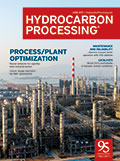
June 2017
Special Focus: Process/Plant Optimization
The maldistribution of liquid flow within long packed beds is a well-known phenomenon in distillation and absorption columns. In a packed column, the maldistribution of liquid results in differences in liquid concentration across the column.
Olefins are major building blocks for petrochemicals. Due to their reactivity and versatility, there has been tremendous growth in the demand for olefins, especially for light olefins such as ethylene, propylene, butenes and 1,3-butadiene, etc.
The history of the refinery and petrochemical industry is filled with a variety of challenges, followed by the development of state-of-the-art technologies to overcome those hurdles. New legislation has required more environmentally friendly product specifications, while energy costs have kept rising.
Solvent deasphalting (SDA) is emerging as a low-cost, bottom-of-the-barrel upgrading process to recover valuable oil from short residue. This oil can either be further processed to make lube-oil-based stocks or cracked in secondary processing units.
Process Control and Instrumentation
Catalytic reformer units convert naphtha into high-octane aromatic compounds called reformates, which are used in gasoline blending and formulation. UOP developed the catalytic reforming process and brought the first unit into operation in 1949.
One of the persistent challenges for refineries blending gasoline is achieving minimum octane ratings economically and without exceeding Reid vapor pressure (RVP) requirements.
Catalysts
Today’s refining strategies rely on a constant optimization of product slate to comply with market demand and economic drivers, refining/petrochemical integration, product specifications, environmental regulations and competition.
Maintenance and Reliability
The bottom pump in crude vacuum units is an area of concern for almost all petroleum oil refineries. The harsh operating parameters in which these pumps operate, including high product temperature and significant vacuum suction pressure, have resulted in frequent vacuum tower upsets and low mean time between failures (MTBF) for vacuum bottom pumps.
The total annual cost of corrosion in the oil and gas production industry is estimated to be $1.372 B.1 More significantly, failures due to corrosion can result in environmental releases and injury or death of plant personnel.
Columns
The pages of <i>Hydrocarbon Processing</i> contain numerous case studies, techniques, advice and step-by-step approaches to optimizing downstream operations. These elements have been the focus of the magazine for the last 95 yr.
Professional advancement is often linked to obtaining certification. To prepare, the technician or engineer must study texts, culminating in taking a test or passing an exam that makes use of, or is based on, questions contributed by subject matter experts.
Technology is changing, and fast. Labor availability and skillset requirements are changing, as well. Process control personnel makeup and skillsets have evolved over decades of iterations. The process industries are challenged to continue to operate efficiently in an increasingly competitive environment.
The Industrial Internet of Things is expected to create a $225-B market by 2020, opening new opportunities for industrial organizations related to data and asset management.
Trends and Resources
The digitalization of the hydrocarbon processing industry (HPI) is in full swing. Numerous companies have created, and are optimizing, digital technologies to improve plant operations, increase energy efficiency and lower costs.
Is a digital revolution underway in the process industry? For years, we have been hearing more and more about the Industrial Internet of Things (IIoT), Industry 4.0, Connected xxx (plant, enterprise, field, performance, etc.), smart Clouds, smart devices and so on. These concepts share numerous similarities, usually with a slightly different twist depending on who is promoting or selling them. But is the hype and buzz rapidly spreading to day-to-day applications and implementations? Not quite.
US gasoline demand increased with the shift to summer fuels and higher export opportunities to Latin America.
<i>Hydrocarbon Processing’s</i> Construction Boxscore Database is tracking more than 1,700 active downstream projects around the world.
Siemens has been working closely with the National Cybersecurity Center of Excellence (NCCoE) at the National Institute of Standards and Technology (NIST) on a cyber security project.
Randy Schmidt has been named Managing Director of the Burns & McDonnell Terminals and Pipelines group, replacing Ted Born, who is retiring.

- China's March jet fuel exports jump 77.4% from a year earlier 4/18
- Nigeria strikes deal with Shell to supply $3.8-B methanol project 4/18
- Singapore fuel oil stockpiles rebound to 8-week high on higher imports 4/18
- Clariant launches new CATOFIN 312 propane dehydrogenation catalyst 4/18
- Solvay inaugurates new blowing agent production unit in Rosignano, Italy 4/18
- Meridian Energy Group’s Davis Refinery Project in North Dakota (U.S.) will be the world’s first net-zero carbon refinery 4/17




